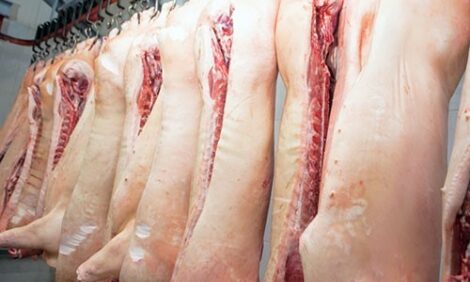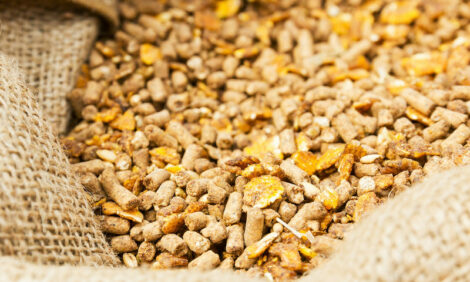



Understanding risks for M. hyo disease can help protect US swine herds
The US swine industry has been battling Mycoplasma hyopneumoniae (M. hyo) for years, writes Maria Jose Clavijo, DVM, PhD for Pig Health Today, but the pathogen is still a major cause of respiratory disease in herds. One way we can better protect swine from M. hyo is by reducing risks for the disease wherever it’s possible to do so.Granted, there are gaps in knowledge. For instance, while it is known that M. hyo can survive in the environment for up to 8 days on dust or plastic, we don’t know whether M. hyo can be spread by fomites (objects or materials that might carry M. hyo), transport vehicles or people. However, there’s a lot we do know.
Take for instance airborne transmission of M. hyo, which has been well documented. M. hyo organisms can be transported via air for nearly 6 miles.1 We know from studies on Swiss farms that swine housed near livestock-transportation parking sites are more likely to become infected with M. hyo.2 This finding suggests livestock vehicles at parking sites are a source of aerosol spread, a scenario that underscores the importance of proper cleaning and disinfection of transport vehicles and equipment.
It also means new swine farms should not be located too near other farms. Existing farms on flat land without wind blocks have a greater risk for disease spread3 and may benefit from adding borders of trees or tall hedges.
Other interesting findings from the Swiss researchers are that farms purchasing animals from multiple sources are at higher risk for re-infection compared to farms that bought from a single source. “Well established, limited trading relationships appear to be advantageous regarding the risk of [M. hyo] reinfection,” they say.4
Management reduced risks
In a study of German herds, M. hyo was less likely to be detected in piglets that had their teeth shortened — only 2.8% (20/747) compared to 5.5% (21/380) in piglets that didn’t receive this treatment.5 The authors don’t know why but speculate that shortened teeth might be linked to increased colostrum uptake or higher daily weight gain due to better milk supply from the sow. This study also demonstrated that two instead of one iron injection during the first week of life was associated with a decreased M. hyo detection rate, possibly due to improved immunity.
The likelihood that piglets had M. hyo-positive nasal swabs increased by 10% for every day longer the suckling period lasted, the researchers found.6
Role of people in transmission questioned
In a separate German study, 14% (16/108) of farmers from M. hyo-positive herds were M. hyo-positive in the nasal cavity.7 Although the viability of the bacteria wasn’t evaluated, it raises the question of whether human M. hyo colonization contributes to the spread of M. hyo among swine populations.
However, in another small pilot study that’s a testament to the benefits of biosecurity, researchers found that farm personnel who had previous contact with M. hyo-infected pigs failed to transmit the bacterium to naive pigs if they used standard hygiene protocols before entering the herd.8 Still, more research is needed regarding the indirect transmission of M. hyo.
Feral swine pose risk
We know feral swine can transmit diseases such as brucellosis to commercial swine, and there’s some evidence they might also pose a risk for transmission of M. hyo.
In a study of different pathogens among feral swine in the US, researchers found nearly 20% had M. hyo-specific antibodies, indicating prior exposure. They say even though other reports of M. hyo infections in feral swine caused only subclinical disease, the potential risk to domestic pigs should be considered “significant.”9
This recommendation takes on added significance in light of a more recent study published in the January 2017 issue of the Journal of Applied Ecology, which says the continental US is “precariously threatened” by the rapid expansion of invasive wild pigs, which could inhabit most of our counties over the next 3 to 5 decades.10 These reports signal the need to protect our domestic herds from feral swine to prevent transmission of disease, including M. hyo.
Once a farm has been exposed to M. hyo, the most frequent source of infection for naive pigs is direct oral-nasal contact with infected pigs. Piglets commonly contract M. hyo from their dams and subsequently become the source of horizontal transmission to post-weaning penmates.11
Impact of gilts, weaning age
Within sow herd populations, there’s evidence that younger-parity females (p1 and p2 gilts) are more likely to carry M. hyo in their respiratory tract compared to older-parity sows, thus perpetuating the disease in the herd.12 This observation has led practitioners to focus on gilts when designing a herd-stabilization program, even though other studies have failed to find a parity difference.
German investigators have found that appropriate acclimation of gilts, a short suckling period and all-in-all-out production could reduce the M. hyo prevalence, improve pig health and welfare, and reduce antimicrobial use.13 They also found an increased probability of M. hyo infection in weaning-age piglets when the gilt replacement rate was above 50% per year or when there were more than 16 pens per farrowing room.14
In a study where researchers used a mathematical model to assess the impact of several risk factors, lower intra-herd transmission of M. hyo was linked to exposure of gilts to M. hyo-infected pigs during gilt acclimation and to piglet vaccination and weaning at 21 days.15
There appear to be numerous potential M. hyo risk factors. By taking action to mitigate known risks that apply to their farms, pork producers and their veterinarians should be able to achieve better prevention — or intervention, as needed — against M. hyo disease.
For detailed information on M. hyo risk management, see A Contemporary Review of Mycopolasma hyopneumoniae Control Strategies.
[1] Otake S, et al. Long-distance airborne transport of infectious PRRSV and Mycoplasma hyopneumoniae from a swine population infected with multiple viral variants. Vet Microbiol. 2010 Oct 26;145(3-4):198-208.
[2] Hege R, et al. Incidence of Reinfections with Mycoplasma hyopneumoniae and Actinobacillus pleuropneumoniae in Pig Farms Located in Respiratory-Disease-Free Regions of Switzerland. Acta Vet Scand. 2002;43:145-156.
[3] Seaman J, et al. Biosecurity for Today’s Swine Operation. University of Missouri Extension. 2001 Nov.
[4] Hege R, et al. Incidence of Reinfections with Mycoplasma hyopneumoniae and Actinobacillus pleuropneumoniae in Pig Farms Located in Respiratory-Disease-Free Regions of Switzerland. Acta Vet Scand. 2002;43:145-156.
[5] Nathues H, et al. Individual risk factors for Mycoplasma hyopneumoniae infections in suckling pigs at the age of weaning. Acta Vet Scand. 2013;55:44.
[6] Ibid.
[7] Nathues H, et al. Detection of Mycoplasma hyopneumoniae in nasal swabs sampled from pig farmers. Vet Rec. 2012 Jun 16;170(24):623.
[8] Batista L, et al. Assessment of transmission of Mycoplasma hyopneumoniae by personnel. J Swine Health Prod. 2004;12(2):75-77.
[9] Baroch JA, et al. Exposure of feral swine (Sus scrofa) in the United States to selected pathogens. Can J Vet Res. 2015 Jan;79(1):74-78.
[10] Snow N, et al. Interpreting and predicting the spread of invasive wild pigs. J Appl Ecol. 2017 Jan 30.
[11] Calsamiglia M, et al. Colonization state and colostral immunity to Mycoplasma hyopneumoniae of different parity sows. Vet Rec. 2000 Apr;146(18):530-532.
[12] Cardona AC, et al. Prevalence of Mycoplasma hyopneumoniae in different parity cull sows. In: Proceedings Allen D. Leman Swine Conference Abstracts, Minneapolis, Minnesota. 2003;38.
[13] Nathues H, et al. Modelling the within-herd transmissions of Mycoplasma hyopneumoniae in closed pig herds. Porcine Health Management. 2016;2:10.
[14] Nathues H, et al. Herd specific risk factors for Mycoplasma hyopneumoniae infections in suckling pigs at the age of weaning. Acta Vet Scand. 2013;55:30.
[15] Nathues H, et al. Compartmental mathematical model of within-herd transmission of M. hyopneumoniae in a pig herd. In: Proceedings 23rd International Pig Veterinary Society Congress, Cancun, Mexico. 2014;92.








